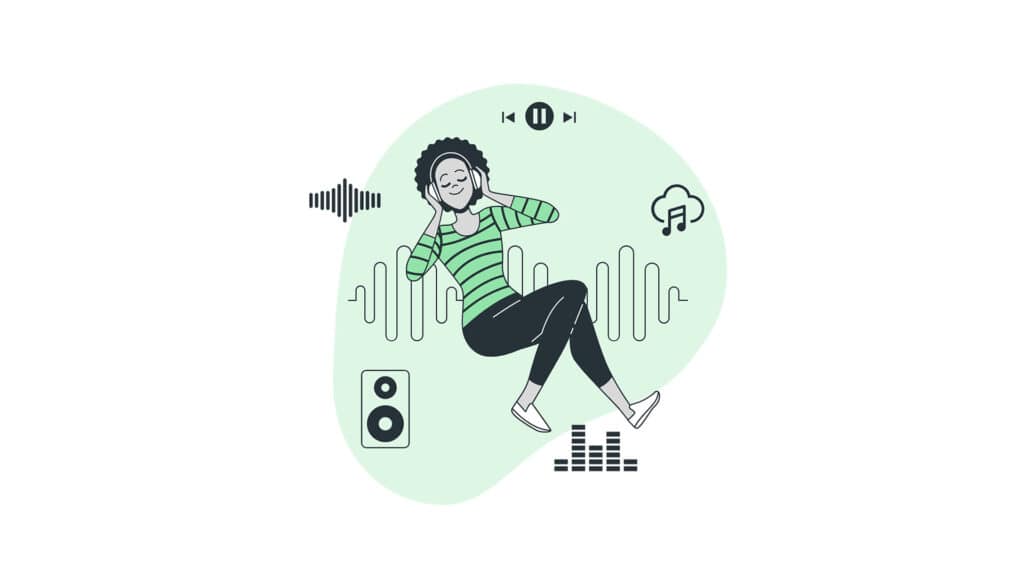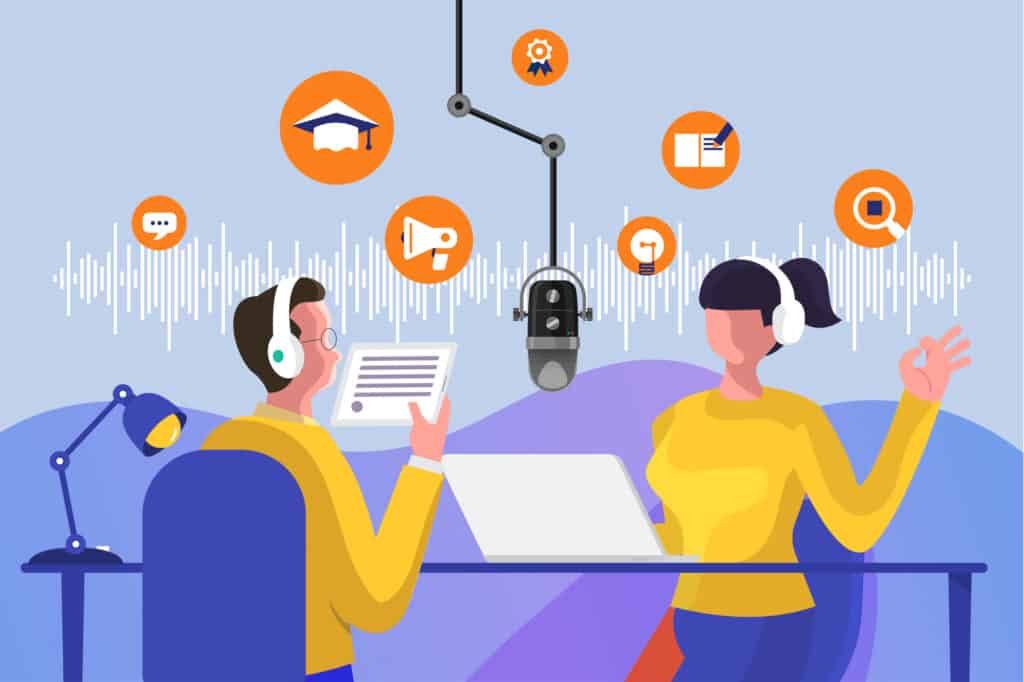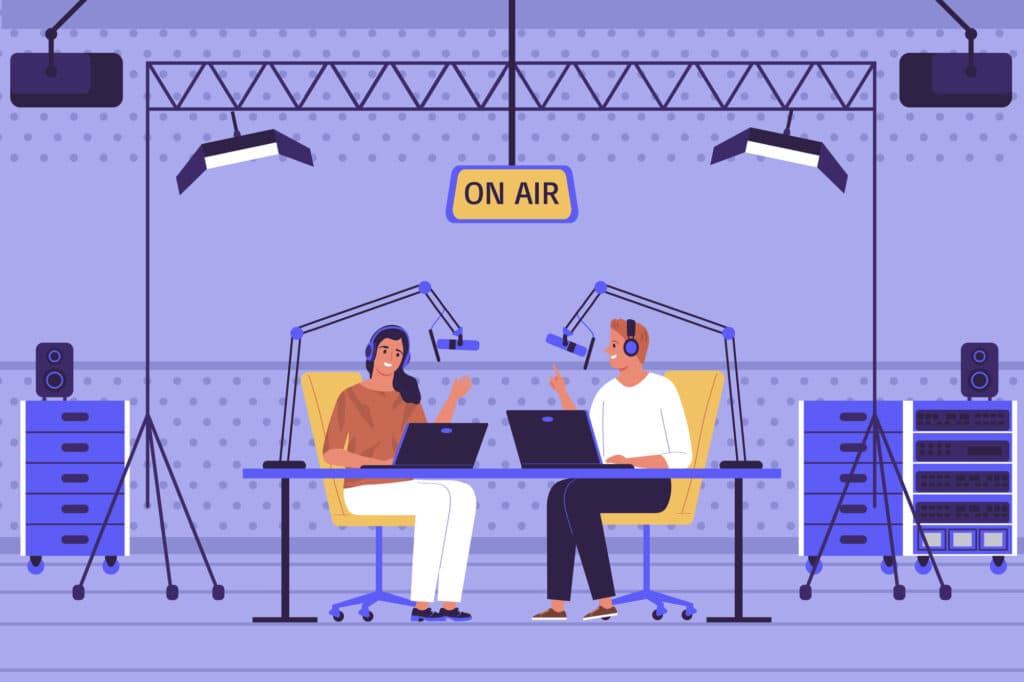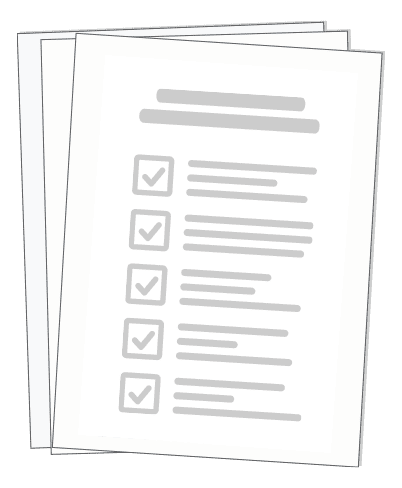
Download Your Free
Ultimate Podcast
Launch Checklist
How to Start a Music Podcast – it’s the siren song for audiophiles seeking to carve their niche in the digital landscape. The rhythm of podcasting isn’t just about hitting play; it’s an art form where you blend your music passion with stories, interviews, and insights that resonate on a personal playlist level.
Dive deep into crafting an identity that sings true to your style while ensuring every technical note is pitch-perfect. Get ready to lay down tracks that’ll make sure quality audio meets compelling content, creating episodes that not only sound good but feel like backstage passes into the music world.
Stick around as we riff through setting up shop from selecting mics and mixing beats with free audio software to marketing moves guaranteed to amplify your reach. Let this be the prelude before you take center stage in listeners’ ears and hearts.
Table of Contents:
- Crafting Your Music Podcast’s Identity
- Technical Essentials for High-Quality Production
- Setting Up Your Music Podcast Infrastructure
- 7 Marketing Tips to Grow Your Listenership
- Navigating Licensing and Legalities of Music in Podcasts
- Creating Engaging Content Consistently
- Technical Essentials for High-Quality Production
- Navigating Licensing and Legalities of Music in Podcasts
- Monetizing Your Passion: Making Money from Your Music Podcast
- Overcoming Common Challenges & Maintaining Momentum
- Conclusion
Crafting Your Music Podcast’s Identity
Every music podcast starts with a spark, an idea that needs the right kind of fuel to ignite. Before you hit record, it’s crucial to define what your show is about and who it’s for. This isn’t just navel-gazing; it’s strategic branding.

Selecting Your Podcast Topic
To start a music podcast that stands out, pick a topic close to your heart but also unique in the market. Are you all about uncovering hidden gems in indie genres or will your episodes dive deep into the stories behind classic rock anthems? Maybe you want to explore how musical trends evolve over time or offer advice on navigating the music industry. Whatever angle fuels your passion, make sure it resonates with others too.
Remember: specificity can be key—a laser focus might help carve out a niche faster than broad strokes could ever hope to paint.
Identifying Your Target Audience
Your target audience is more than an age group—it’s people whose interests align with yours and who are looking for something special in their playlist rotation. They’re not just listeners; they’re co-pilots on this sonic journey. To tailor content they’ll love, think about why someone would tune into your particular style of music storytelling—what makes them tick musically?
Analyzing platforms like Apple podcasts can give insights into listener preferences so don’t shy away from doing some digging around.
Defining Your Podcast Style
The style of your podcast—whether conversational or narrative-driven—is its heartbeat. It sets the rhythm for every episode and informs decisions down the line from intro music selection (should it be royalty-free tunes or licensed tracks?) to whether each session should have an interview format featuring musicians discussing their craft.
Audiences crave authenticity as much as quality audio—so when selecting equipment consider both technical specs and how well they capture ‘you’. A digital microphone ensuring crisp sound combined with free audio software like Audacity allows polish without losing personality.
Technical Essentials for High-Quality Production
Creating a podcast that keeps listeners coming back starts with crisp, clear audio. It’s not just about what you say; it’s how you sound saying it.
Choosing the Right Recording Equipment
To get that studio-quality sound, investing in good recording equipment is key. A solid digital microphone doesn’t just pick up your voice; it captures the emotion and energy behind every word. And remember, while your laptop mic might be convenient, it won’t give you the quality audio necessary to keep listeners engaged.
The right recording device can mean fewer post-production headaches. It’s like finding a guitar that stays in tune—less time tweaking means more time creating content.
Utilizing Professional Audio Software
Edit and polish with advanced audio software because no one wants to listen to raw recordings riddled with ums and ahs or plagued by background noise. Audacity offers free audio software tools that are super simple yet powerful enough to let even beginners produce something close to magic.
An essential tool in this kit? The compressor filter—it evens out those loud spikes when your excitement jumps through the roof as well as boosts softer sounds so words don’t get lost in translation. Your podcast episodes will thank you for giving them such smooth treatment.
Audacity, known for its robust editing capabilities without draining wallets, ensures every episode meets high standards of clarity and professionalism.
We all know ears are unforgiving if assaulted by poor-quality production—and statistics hammer home this truth: crystal-clear sound retains audiences better than any catchy jingle could hope to do alone. So take control of your music podcast destiny: arm yourself with reliable gear and professional-grade software from day one.
Setting Up Your Music Podcast Infrastructure
If you’re thinking about launching a music podcast, know that your infrastructure is the stage on which your show performs. It’s got to be rock-solid.
Finding a Reliable Podcast Hosting Service
A great hosting service isn’t just an online locker for your episodes; it’s like the manager of your band—keeping things organized and setting you up for success. Look for a platform that not only stores but also helps distribute your content. This means submitting podcasts with ease so fans can find you on their favorite apps like Apple or Spotify. A user-friendly website linked to this host can crank up engagement by making it super simple for listeners to hit play or read more about what they’re hearing.
But don’t just take any roadie’s word for it, go backstage and check out platforms firsthand. Stability matters because when those fan numbers start climbing (and they will if you’ve got the tunes), you want zero hiccups during peak listening times.
Creating an Online Presence That Resonates
Your podcast website is essentially album cover art—it needs to grab attention in all the right ways while still being easy to navigate through, much like flipping through vinyl at a record store. Whether DIY-ing with free tools or investing in professional design help, make sure every visit strikes a chord with visitors leading them naturally towards pressing ‘play’ on new episodes.
Social media channels are virtual concert venues where sharing snippets of upcoming shows can generate buzz among potential listeners who might not have found you otherwise—but always remember: quality over quantity. It’s better to have meaningful interactions across fewer platforms than spreading yourself too thin without truly engaging anyone anywhere.
In conclusion, getting these foundational elements dialed-in sets everything else into motion—from recording gear choices down to marketing moves—and let me tell ya’, there’s nothing passive about running this kind of business.
7 Marketing Tips to Grow Your Listenership
Leveraging Social Media Platforms
Social media is like the town square for today’s digital world. It’s where conversations happen, opinions are formed, and trends take off. If you want your music podcast to be the talk of the town, get savvy with social media networks. Create engaging posts that echo your passion for music and invite fans into a conversation about their favorite episodes.
To really strike a chord on platforms like Twitter or Instagram, share snippets of upcoming podcast episodes or behind-the-scenes content that gives listeners an insider view. And remember, it’s not just about broadcasting; it’s also about listening and interacting with your audience.
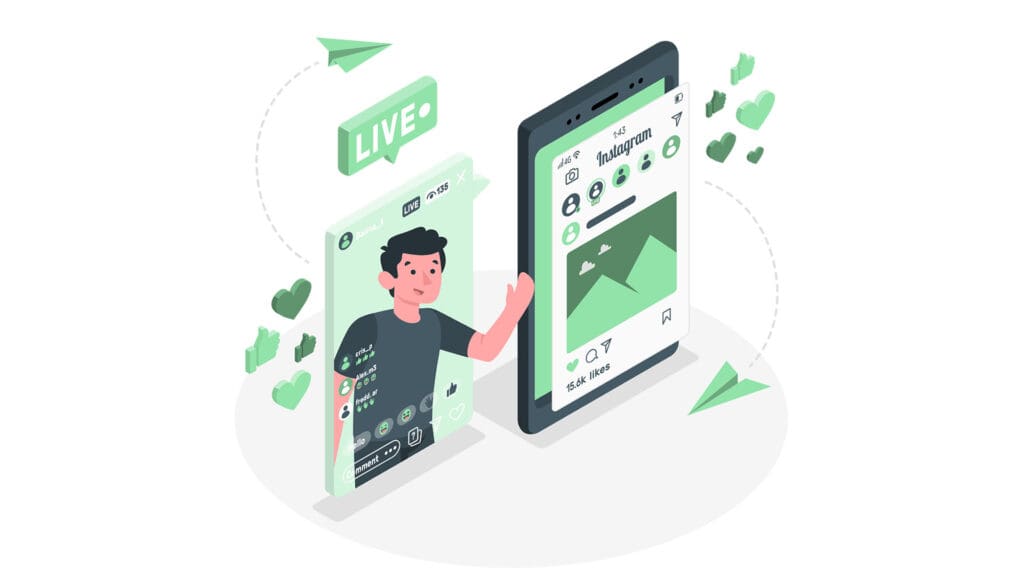
Getting Listed on Major Directories
Your podcast might be music to someone’s ears—but only if they can find it. Spotify, Apple Podcasts, Google Podcasts—these are some of the big stages where over 95% of all podcast listeners gather. Submitting your show here is super simple but can significantly boost visibility.
Geniuslink management tools help track who tunes in from where which lets you know what works best in drawing new crowds—and let me tell ya’, getting this intel is as valuable as an encore at a sold-out concert.
Crafting Shareable Cover Art
The cover art for your podcast isn’t just window dressing—it’s often the first thing potential listeners see before hitting play. So make sure yours stands out like a hit single on top charts by creating artwork that captures both their eyes and curiosity.
Creating Catchy Theme Songs & Intro Music
A catchy theme song or specialized intro tune does more than start each episode off on a high note; think of them as audio handshakes inviting folks into each session with warmth and personality.
Publish Episodes Consistently
You wouldn’t keep fans waiting at a gig—so don’t do it with your podcasts either. Regular publishing keeps audiences hooked because predictability builds trust… kind of how everyone expects an amazing guitar solo during certain songs live.
Incorporate Listener Feedback
Giving shout-outs to listener comments makes people feel seen much like spotlighting audience members rocking out at shows. This inclusion fosters community around shared love: great tunes discussed between friends (even virtual ones).
Dabble In Paid Advertising
Investing in targeted ads can be a smart move, particularly if you’re aiming to break into new markets where organic strategies alone won’t cut it. Just remember to spend your budget wisely and strategically.
Navigating Licensing and Legalities of Music in Podcasts
Imagine you’ve just created a killer podcast episode, but wait—before you hit ‘publish’, let’s talk about music rights. Using someone else’s tune without permission could be like grabbing the electric guitar at a rock concert—it might seem fun until security shows up. So, how do we avoid that awkward moment with our podcasts?
Licensing Music: The Right Way to Rock Out on Your Episodes
Here’s where licensing comes into play. To legally include music in your episodes, consider royalty-free tracks as your backstage pass to hassle-free content creation. Royalty-free music lets you set the mood for your intro or outro segments without fretting over legal woes.
If royalty-free sounds too generic and you’re after something more unique, it’s time to chat about theme songs crafted by indie artists or specialized services—just make sure their work fits into your budget like those old jeans from high school (we know they still fit).
Covering Your Tracks: Understanding Copyright Laws
Diving deeper than just knowing free audio software, grasping copyright laws is essential if you want more control over your soundscapes while supporting fellow creators—a win-win.
You can opt for platforms offering pre-cleared tunes which are kind of like all-you-can-eat buffets—you pay once and feast on beats galore. Or better yet? Network with musicians directly; not only will this personalize your show, but who doesn’t love making new friends?
Finding Harmony: Selecting Appropriate Intro and Outro Tunes
Choosing intro and outro tunes isn’t simply picking what makes us headbang most vigorously—it should reflect our brand personality as well as resonate with listeners (who hopefully aren’t wearing earplugs). Whether it’s free music or licensed bangers from budding artists in the industry—aim for cohesiveness across episodes so fans feel right at home every time they press play.
Remember folks, proper licensing is key—not only does it keep lawyers off our tailbacks but also props up talented artists waiting for their big break (or even just enough doughnuts). So next time before releasing that awesome podcast rss feed out into the wild web through directories tab upon directories tab – pause. Make sure everything resonates harmoniously within both legal frameworks AND earbuds alike.
Creating Engaging Content Consistently
To run a successful music podcast, you’ve got to hit the right notes with your content. Keeping it fresh and engaging is like crafting a killer playlist—it keeps listeners coming back for more.
Selecting Your Podcast Topic
Picking a topic isn’t just about what’s hot; it’s finding that sweet spot between your passion and what strikes a chord with others. Imagine your ideal listener—is she jamming out to indie tracks or craving deep dives into music history? There lies your show’s heart.
Now, mix in some unique flavor. Got an angle on how tunes influence fashion trends? Or perhaps insights on underground hip-hop scenes around the globe? That’s gold—use it.
Identifying Your Target Audience
Your audience isn’t just anyone who digs music—they’re the VIPs at your backstage party. Figure out their vibe—are they industry insiders looking for pro tips or weekend warriors searching for new beats?
Talk directly to them through every episode as if they’re sitting across from you in the studio, head nodding along to every word.
Defining Your Podcast Style
The style of your podcast sets the stage—it could be laid-back chats reminiscent of late-night radio shows or energetic banter that gets hearts racing faster than drum solos at live gigs.
Free audio software, when used effectively, can amplify this experience by polishing each recording until it shines.
Technical Essentials for High-Quality Production
We know good quality audio holds onto listeners like catchy choruses keep songs stuck in heads—indispensable. Investing in a digital microphone that captures clear sound, paired with professional editing software, ensures every whisper and riff resonates perfectly.
Navigating Licensing and Legalities of Music in Podcasts
Licensing may not rock our world but getting legalities tuned up means we avoid sour notes later down the line. Use royalty-free tracks or secure rights properly—you’ll sleep better knowing no one will pull the plug mid-setlist.
With these chords struck right—topic selection aligned with passions, speaking direct-to-audience style crafted carefully—the rhythm of creating consistent engaging content becomes second nature.
Choose a topic that vibes with your passion and resonates with listeners. Think unique angles—like tunes influencing fashion or global underground hip-hop—to really shine.
Your audience is special; treat them like VIPs in every episode, chatting as if they’re right there with you.
Set your podcast’s tone—it could be chill chats or pumped-up talk. Use free audio software well to make each session pop.
Invest in quality gear for sound that sticks and use editing tools for polish—that’s how you’ll keep ears locked on your show.
Nail down those licensing details early so legal woes don’t kill your groove later—you want uninterrupted playtime for everyone involved.
Monetizing Your Passion: Making Money from Your Music Podcast
Turning your music podcast into a money-making venture isn’t just a dream; it’s entirely possible with the right monetization strategies. Let’s get real about cashing in on those tunes and talks.
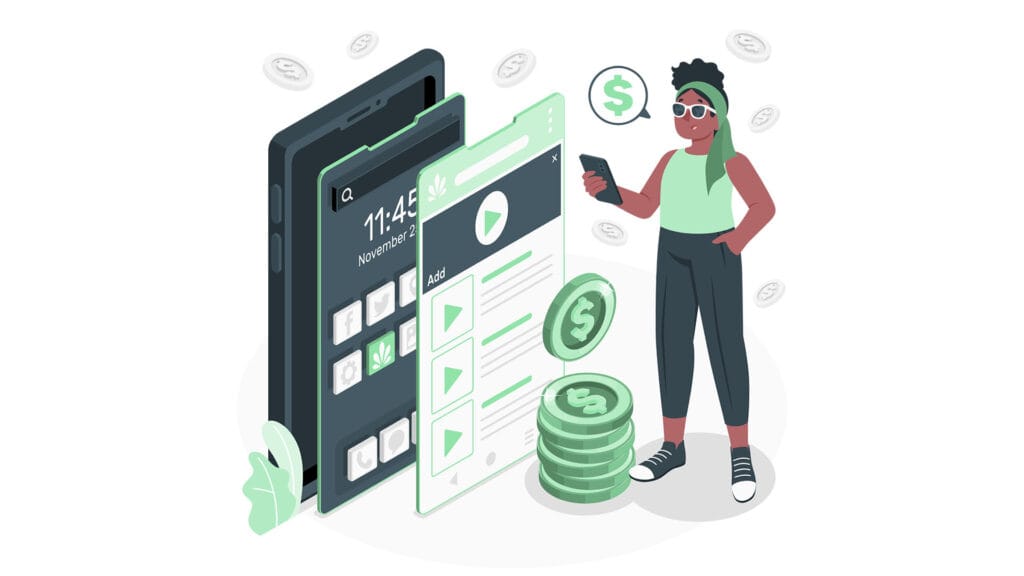
Sponsorships: The Golden Ticket to Revenue
Picture this: brands paying you to talk up their products because they love your style and reach. It happens when you align with sponsors that resonate with your audience. You’ve got the listeners, they’ve got the goods – it’s a match made for profit.
To start, create an engaging media kit that showcases your listener demographics and download stats. Reach out to music businesses who’d be thrilled to hit the airwaves of your show.
Fan-Funded Support through Patreon & Donations
Your fans adore what you do, so why not let them chip in? Platforms like Patreon are perfect for setting up membership tiers offering exclusive content or shoutouts in exchange for financial support. Even simple donation buttons can lead to surprising contributions from loyal followers who want nothing more than to see (and hear) you succeed.
Making Merch Move
T-shirts with catchy phrases from your latest episode or hats sporting your logo aren’t just fashion statements—they’re walking advertisements generating revenue while promoting brand loyalty among podcast listeners.
Affiliate Marketing: Earn While They Shop
You mention a killer pair of headphones during an episode—why not earn from that recommendation? Affiliate marketing lets you collect commissions every time someone buys products using links shared by you. It’s passive income at its finest as long as those recommendations stay genuine and useful.
Leveraging Advertising without Losing Soul
Dive into advertising but keep it cool; nobody likes a sell-out. Carefully chosen ads related directly to music lovers will feel less intrusive and maintain trust between host—you—and those tuning in each week seeking great beats and savvy insights into the music industry.
Overcoming Common Challenges & Maintaining Momentum
So, you’ve launched a podcast. Welcome to the club. But even with that shiny new microphone and the buzz of your first episodes under your belt, challenges are bound to pop up—technical issues, recording problems, or maybe engagement’s just not where you want it to be.
Finding Fixes for Technical Glitches
No one said podcasting was easy—and they were right. Sometimes equipment acts like it has a mind of its own. One day everything works fine; next thing you know, your audio sounds like you’re broadcasting from Mars. A solid compressor filter can save the day by smoothing out those unwanted spikes in sound quality. When editing throws curveballs at you, remember: free audio software such as Audacity is there to help make post-production less about stress and more about finesse.
But let’s talk RSS feed—it’s like the lifeline between your podcast and listeners’ ears through their favorite app. An issue here means radio silence instead of radio fame. Double-check all settings or use services that simplify this step (Buzzsprout Podcast comes highly recommended). It makes getting into directories super simple so people can actually find and enjoy what you’re creating.
Dodging Hosting Hurdles
Picking a hosting service? Think stability meets scalability because nobody likes crashing sites when traffic spikes as your podcast grows big time—a real mood killer for both host and audience alike. Plus having user-friendly web pages keeps folks sticking around longer than an awkward pause on air.
The Art of Audience Engagement & Retention
Gaining listeners feels great but keeping them is another story—they need good reasons to hit play again (and nope, cliff-hangers don’t count). We’re talking engaging content delivered consistently with future episodes they wouldn’t dare miss.
- If social media platforms are playing hardball in helping gain followers,
- a nifty trick could be running contests where winners get shoutouts during shows—who doesn’t love feeling special?
- It takes time and persistence to make it in the music industry, with its fair share of challenges.
Remember this: while facing technical issues head-on may feel overwhelming at times, Audacity’s free platform makes tackling recording problems easier than hitting replay on your favorite tune.
Conclusion
So you’ve tuned into the essentials of how to start a music podcast. Remember, your podcast’s identity is key; it’s what makes your soundwave stand out in an ocean of tunes.
Make sure every episode resonates with crystal-clear quality audio and strikes a chord with listeners through engaging content. You’ve learned that having reliable recording equipment isn’t just helpful—it’s crucial for hitting those high notes.
Dive deep into marketing techniques because they’re your backstage pass to growing an audience. Keep things rolling smoothly by navigating the legal side of using music—this way, artists get their due and your show stays on the air.
Finally, stay consistent. Just like in any successful music career, regular beats keep fans hooked. Now take these tips and mix up something amazing—the stage is set for you to amplify your passion!

Download Your Free
Ultimate Podcast
Launch Checklist

